FRONT BRAKE
|
Removing the front brake caliper 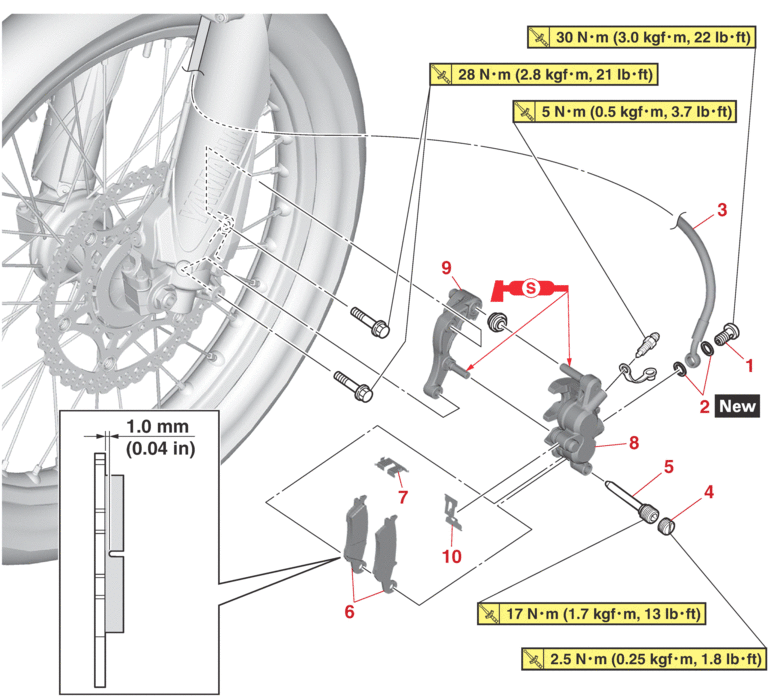 |
|||
|---|---|---|---|
|
Order |
Job/Parts to remove |
Q’ty |
Remarks |
|
|
Brake fluid |
|
Drain. Refer to BLEEDING THE HYDRAULIC BRAKE SYSTEM. |
|
1 |
Union bolt |
1 |
|
|
2 |
Copper washer |
2 |
|
|
3 |
Front brake hose |
1 |
|
|
4 |
Brake pad pin plug |
1 |
|
|
5 |
Brake pad pin |
1 |
|
|
6 |
Brake pad |
2 |
|
|
7 |
Brake pad spring |
1 |
|
|
8 |
Front brake caliper assembly |
1 |
|
|
9 |
Front brake caliper bracket |
1 |
|
|
10 |
Brake pad spring |
1 |
|
|
Disassembling the front brake caliper 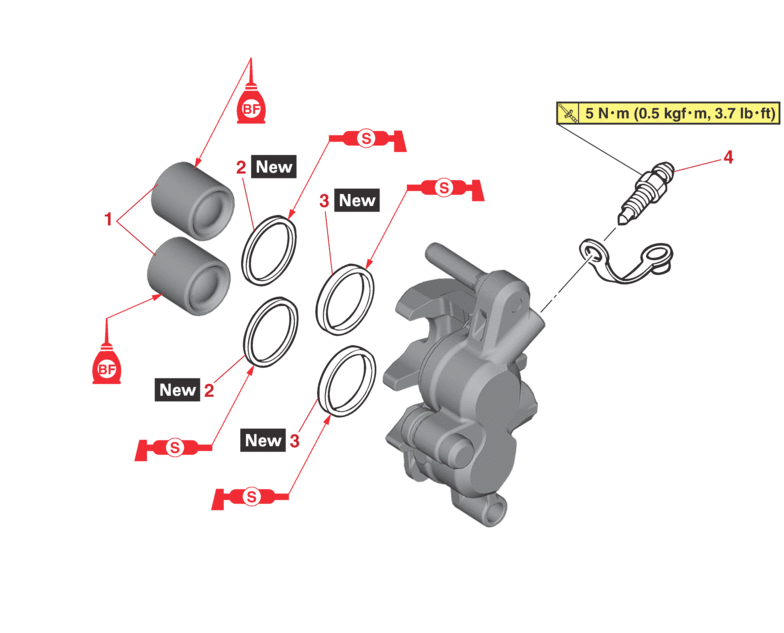 |
|||
|---|---|---|---|
|
Order |
Job/Parts to remove |
Q’ty |
Remarks |
|
1 |
Brake caliper piston |
2 |
|
|
2 |
Brake caliper piston dust seal |
2 |
|
|
3 |
Brake caliper piston seal |
2 |
|
|
4 |
Bleed screw |
1 |
|
|
Removing the front brake master cylinder 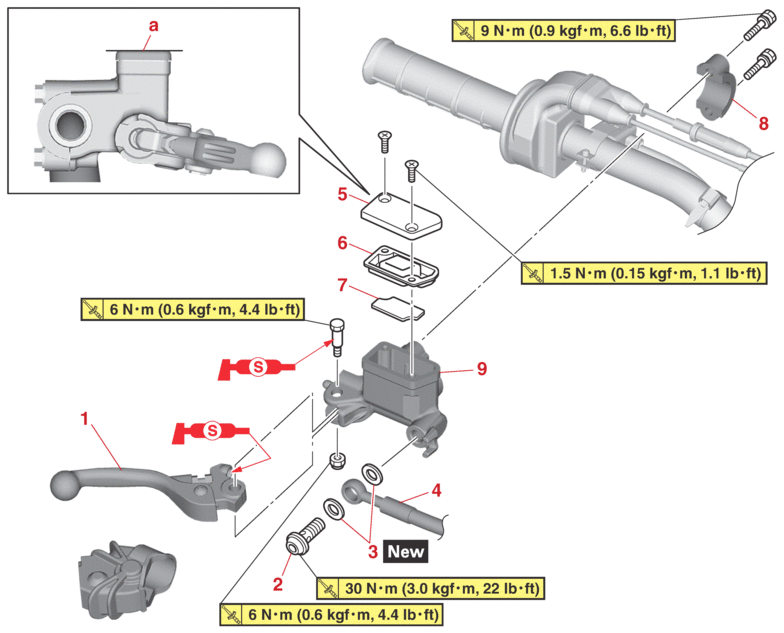 |
|||
|---|---|---|---|
|
Order |
Job/Parts to remove |
Q’ty |
Remarks |
|
|
Brake fluid |
|
Drain. Refer to BLEEDING THE HYDRAULIC BRAKE SYSTEM. |
|
1 |
Brake lever |
1 |
|
|
2 |
Union bolt |
1 |
|
|
3 |
Copper washer |
2 |
|
|
4 |
Front brake hose |
1 |
|
|
5 |
Brake master cylinder reservoir cap |
1 |
Adjust the front brake master cylinder so that the top “a” of the brake master cylinder reservoir cap is horizontal. |
|
6 |
Brake master cylinder reservoir diaphragm |
1 |
|
|
7 |
Front brake master cylinder float |
1 |
|
|
8 |
Front brake master cylinder holder |
1 |
|
|
9 |
Front brake master cylinder |
1 |
|
|
Disassembling the front brake master cylinder 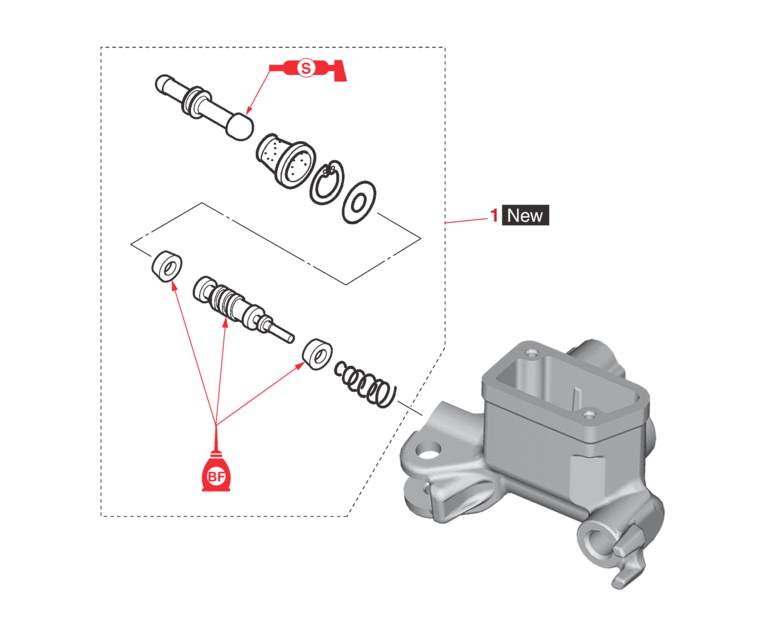 |
|||
|---|---|---|---|
|
Order |
Job/Parts to remove |
Q’ty |
Remarks |
|
1 |
Brake master cylinder kit |
1 |
|
INTRODUCTION
|
CHECKING THE FRONT BRAKE DISC
1.Check:
-
Front brake disc
Damage/galling → Replace.
2.Measure:
-
Brake disc thickness
Measure the brake disc thickness at a few different locations.
Out of specification → Replace.
|
3.Measure:
-
Brake disc runout
Out of specification → Replace the brake disc.
|
a.Place the vehicle on a maintenance stand so that the front wheel is elevated.
b.Remove the brake caliper.
c.Hold the dial gauge at a right angle against the brake disc surface.
d.Measure the runout 1.5 mm (0.06 in) above the brake disc edge.
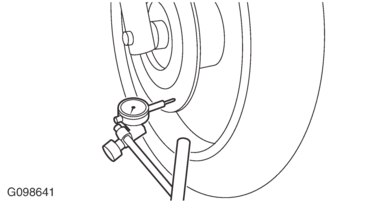
4.Replace:
-
Brake disc
Refer to ASSEMBLING THE FRONT WHEEL.
REPLACING THE FRONT BRAKE PADS
|
1.Remove:
-
Brake pad
a.Remove the pad pin plug “1”.
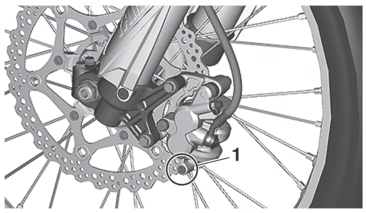
b.Loosen the pad pin “2”.
c.Remove the brake caliper “3” from the front fork.
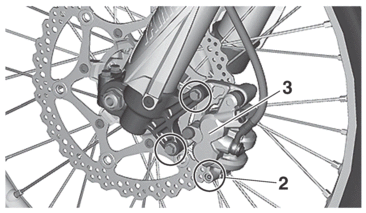
d.Remove the pad pin and brake pads “4”.
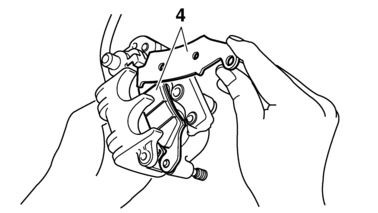
2.Measure:
-
Brake pad wear limit “a”
Out of specification → Replace the brake pads as a set.
|
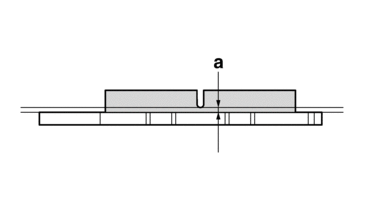
3.Install:
-
Brake pad
a.Connect the plastic hose “1” to the bleed screw “2” and place a container under the end of the plastic hose.
b.Loosen the bleed screw and push the brake caliper piston in.
|
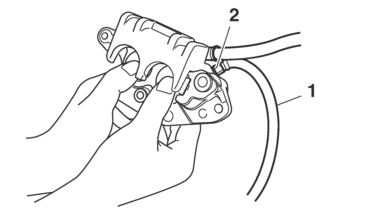
c.Tighten the bleed screw.
|
d.Install the brake pads “3” and the pad pin.
|
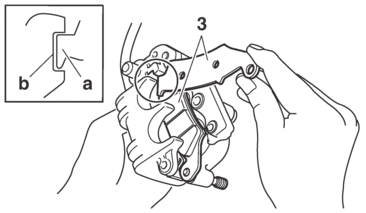
e.Install the brake caliper “4” and tighten the pad pin “5”.
|
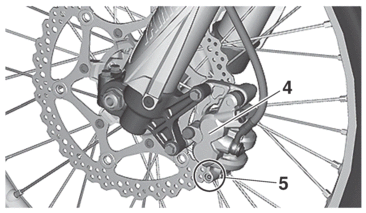
f.Install the pad pin plug “6”.
|
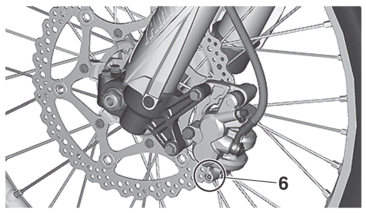
4.Check:
-
Brake fluid level
Refer to CHECKING THE BRAKE FLUID LEVEL.
5.Check:
-
Brake lever operation
A softy or spongy feeling → Bleed the brake system.
Refer to BLEEDING THE HYDRAULIC BRAKE SYSTEM.
REMOVING THE FRONT BRAKE CALIPER
|
1.Remove:
-
Union bolt
-
Copper washer
-
Brake hose
|
DISASSEMBLING THE FRONT BRAKE CALIPER
1.Remove:
-
Brake caliper piston “1”
-
Brake caliper piston dust seal “2”
-
Brake caliper piston seal “3”
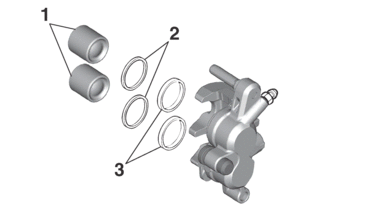
a.Blow compressed air into the brake hose joint opening to force out the piston from the brake caliper.
|
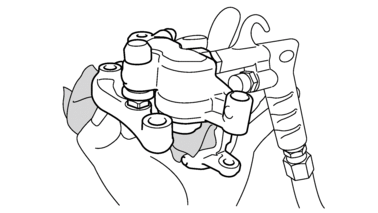
b.Remove the brake caliper piston dust seal and the brake caliper piston seal.
CHECKING THE FRONT BRAKE CALIPER
1.Check:
-
Brake caliper piston “1”
Rust/scratches/wear → Replace the brake caliper piston.
-
Brake caliper cylinder “2”
Scratches/wear → Replace the brake caliper assembly.
-
Brake caliper body “3”
Cracks/damage → Replace the brake caliper assembly.
-
Brake fluid delivery passages
(brake caliper body)
Obstruction → Blow out with compressed air.
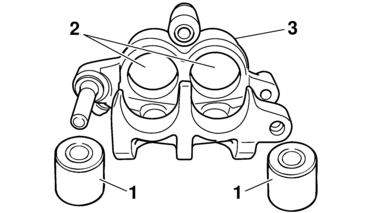
|
2.Check:
-
Brake caliper bracket
Crack/damage → Replace.
ASSEMBLING THE FRONT BRAKE CALIPER
|
|
INSTALLING THE FRONT BRAKE CALIPER
1.Install:
-
Front brake caliper bracket
-
Front brake caliper
(temporarily)
-
Copper washer

-
Brake hose
-
Union bolt
|
|
|
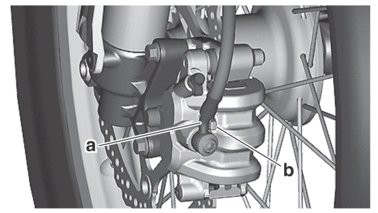
2.Install:
-
Front brake caliper
-
Brake pad spring
-
Brake pad
-
Brake pad pin
-
Brake pad pin plug
-
Plate
|
Refer to CHECKING THE FRONT BRAKE PADS.
3.Tighten:
-
Plate bolt “1”
|
|
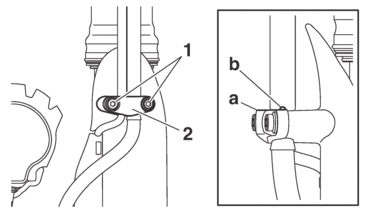
4.Pour brake fluid to the brake master cylinder reservoir up to the specified level.
|
|
|
5.Bleed:
-
Brake system
Refer to BLEEDING THE HYDRAULIC BRAKE SYSTEM.
6.Check:
-
Brake fluid level
The minimum level mark or below → Add.
Refer to CHECKING THE BRAKE FLUID LEVEL.
7.Check:
-
Brake lever operation
A softy or spongy feeling → Bleed the brake system.
Refer to BLEEDING THE HYDRAULIC BRAKE SYSTEM.
REMOVING THE FRONT BRAKE MASTER CYLINDER
|
1.Remove:
-
Union bolt
-
Copper washer
-
Brake hose
|
CHECKING THE FRONT BRAKE MASTER CYLINDER
1.Check:
-
Brake master cylinder “1”
Damage/scratches/wear → Replace the brake master cylinder assembly.
-
Brake fluid delivery passages “2”
(brake master cylinder body)
Obstruction → Blow out with compressed air.
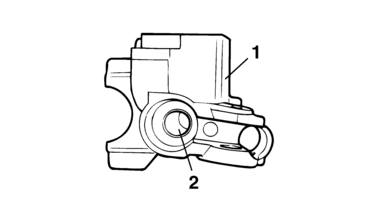
2.Check:
-
Brake master cylinder reservoir cap
Damage/scratches/wear → Replace.
3.Check:
-
Brake hose
Cracks/damage/wear → Replace.
ASSEMBLING THE FRONT BRAKE MASTER CYLINDER
|
|
1.Wash the brake master cylinder with brake fluid.
2.Install:
-
Primary cylinder cup “1”
-
Secondary cylinder cup “2”
(to the brake master cylinder piston “3”)
|
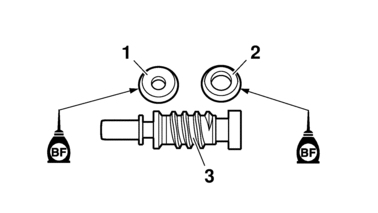
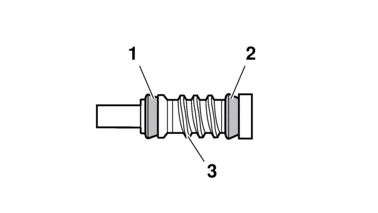
3.Install:
-
Spring “1”
(to the brake master cylinder piston “2”)
|
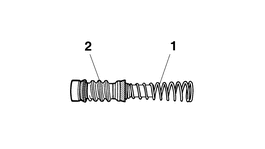
4.Install:
-
Brake master cylinder piston assembly “1”

-
Washer “2”
-
Circlip “3”

-
Dust boot “4”
-
Push rod “5”
|
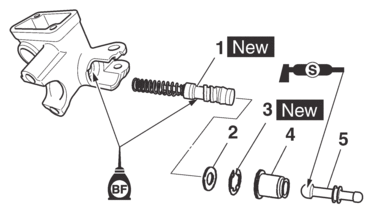
INSTALLING THE FRONT BRAKE MASTER CYLINDER
1.Install:
-
Brake master cylinder “1”
|
|
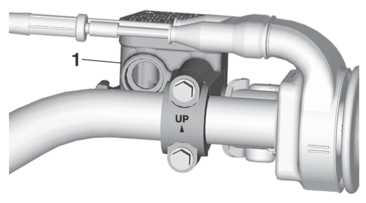
2.Install:
-
Copper washer

-
Brake hose
-
Union bolt
|
|
|
|
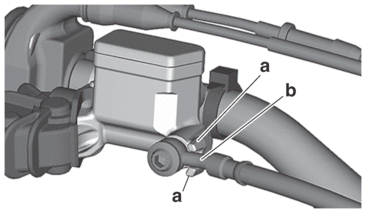
3.Pour brake fluid to the brake master cylinder reservoir up to the specified level.
|
|
|
4.Bleed:
-
Brake system
Refer to BLEEDING THE HYDRAULIC BRAKE SYSTEM.
5.Check:
-
Brake fluid level
The minimum level mark or below → Add.
Refer to CHECKING THE BRAKE FLUID LEVEL.
6.Check:
-
Brake lever operation
A softy or spongy feeling → Bleed the brake system.
Refer to BLEEDING THE HYDRAULIC BRAKE SYSTEM.







